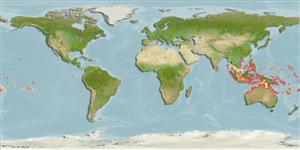>
Ovalentaria/misc (Various families in series Ovalentaria) >
Pomacentridae (Damselfishes) > Pomacentrinae
Etymology: Chrysiptera: Greek, chrysos = golden + Greek, pteron = fin, wing (Ref. 45335); rollandi: Named for Mr. Jean Rolland (R.Bajol, pers.comm. 06/16).
Eponymy: Jean Rolland (1933–2018) was a highly skilled welder by trade. [...] (Ref. 128868), visit book page.
More on author: Whitley.
Environment: milieu / climate zone / Tiefenbereich / distribution range
Ökologie
seewasser riff-verbunden; standorttreu; tiefenbereich 2 - 35 m (Ref. 7247). Tropical; 20°N - 23°S
Eastern Indian Ocean and Western Pacific: Andaman Sea to the Loyalty Islands, north to the Philippines, south to the Great Barrier Reef and New Caledonia. Recently recorded from Tonga (Ref. 53797).
Size / Gewicht / Alter
Geschlechtsreife: Lm ? range ? - ? cm
Max length : 7.5 cm TL Männchen/unbestimmt; (Ref. 48636)
Rückenflossenstacheln (insgesamt) : 13; Rückenflossenweichstrahlen (insgesamt) : 10 - 11; Afterflossenstacheln: 2; Afterflossenweichstrahlen: 12 - 13.
Body shape (shape guide): fusiform / normal; Cross section: compressed.
Adults occur singly or in small groups in lagoons, harbors, and outer reef slopes. Found among corals and coral rubble (Ref. 9710). Feed mainly on zooplankton. Oviparous, distinct pairing during breeding (Ref. 205). Eggs are demersal and adhere to the substrate (Ref. 205). Males guard and aerate the eggs (Ref. 205). DNA analysis suggests that this species could be divided to three species at least, i.e. fish from (1) Andaman Sea, (2) Indo-Australian archipelago, and (3) New Caledonia and southern Coral Sea are distinct species. Diurnal species (Ref. 54980; 113699).
Life cycle and mating behavior
Geschlechtsreife | Fortpflanzung | Ablaichen | Eier | Fecundity | Larven
Oviparous, distinct pairing during breeding (Ref. 205). Eggs are demersal and adhere to the substrate (Ref. 205). Males guard and aerate the eggs (Ref. 205).
Allen, G.R., 1991. Damselfishes of the world. Mergus Publishers, Melle, Germany. 271 p. (Ref. 7247)
IUCN Rote Liste Status (Ref. 130435: Version 2025-1)
Bedrohung für Menschen
Harmless
Nutzung durch Menschen
Fischereien: nicht kommerziell; Aquarium: Kommerziell
Tools
Zusatzinformationen
Download XML
Internet Quellen
Estimates based on models
Preferred temperature (Ref.
123201): 25.7 - 29.3, mean 28.6 °C (based on 2147 cells).
Phylogenetic diversity index (Ref.
82804): PD
50 = 0.5000 [Uniqueness, from 0.5 = low to 2.0 = high].
Bayesian length-weight: a=0.01479 (0.00651 - 0.03363), b=3.00 (2.81 - 3.19), in cm total length, based on LWR estimates for this (Sub)family-body shape (Ref.
93245).
Trophic level (Ref.
69278): 2.7 ±0.30 se; based on food items.
Widerstandsfähigkeit (Ref.
120179): hoch, Verdopplung der Population dauert weniger als 15 Monate. (Preliminary K or Fecundity.).
Fishing Vulnerability (Ref.
59153): Low vulnerability (10 of 100).
🛈
Nutrients (Ref.
124155): Calcium = 150 [84, 257] mg/100g; Iron = 0.95 [0.59, 1.49] mg/100g; Protein = 18.5 [17.5, 19.5] %; Omega3 = 0.162 [0.099, 0.256] g/100g; Selenium = 23.6 [13.4, 42.8] μg/100g; VitaminA = 138 [48, 403] μg/100g; Zinc = 2.37 [1.64, 3.27] mg/100g (wet weight);
